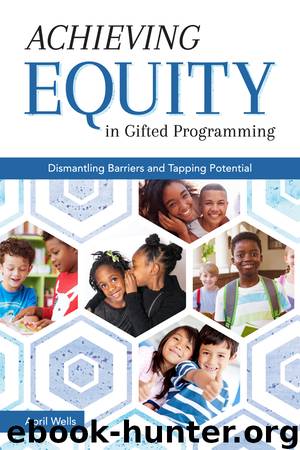Achieving Equity in Gifted Programming by April Wells

Author:April Wells
Language: eng
Format: epub
Publisher: Sourcebooks
CHAPTER 4
Talent Spotting
Raising awareness about what privilege looks like in gifted programming involves heavy lifting. National norm comparisons for gifted identification have been widely used for years. Addressing the inequities that arise from such restrictive identification protocols has proven to be difficult. Educators, parents, and stakeholders who hold longstanding perceptions of giftedness and notions of exceptionality may be reluctant to respond to the inequities and cast wider nets for gifted identification. In a field that has historically and overwhelmingly identified White and Asian students for services, equitable identification has been criticized for permitting “unqualified” students to access programming. At the same time, the field at large recognizes the constraints of gifted programs, namely with regard to identification and the unequal results it yields, but there has not been clear focus on ways to remedy underrepresentation.
The notion of exceptionality has historically been associated with Whiteness and middle-class values. Raising awareness about underrepresentation is only the beginning. Challenges abound with implementations aimed at addressing underrepresentation and creating responsive practices that will yield sustainable participation by students from diverse populations. Although disproportionality (i.e., inequities in participation in gifted programs by students from diverse populations) is easy to identify, sustainable strategies aimed at making strides in responsive participation can be challenging to implement. This shift allows educators to tap potential of students who are overwhelming excluded from programs for high-ability learners. Although 2014 was the first year that schools were majority minority, gifted programs have not evolved to reflect the population shift. For example, according to national statistics, in the 2013–2014 school year, Black (15.5%) and Latino (24.8%) students made up 40.3% of the public school population, but they only made up 28% of students in gifted programs (U.S. Department of Education, Office for Civil Rights, 2014). Emergent bilinguals or ELLs were the most disproportionately represented groups.
Talent development not only is a potential pathway to gifted services, but also may be a way to close the excellence gap.
Elitist gifted programs assess students’ privilege. With an understanding of the power of language and an awareness of culture, the intersectionality of identity is foundational in talent development programs. For years, educators have identified students and then served them; talent development flips that model. Students are provided exposure to enrichment as a platform for their talents to emerge and be nurtured. Talent development is a way to level the playing field for students who have not had similar previous opportunities for learning when compared to those of their more affluent peers. Talent development can be a service in the continuum of services, acting as one delivery model in the umbrella of gifted services. Talent development not only is a potential pathway to gifted services, but also may be a way to close the excellence gap. The excellence gap measures the disproportionate participation rates of low-income students in advanced learning environments as well as the unequal outcomes of students from low-income households at advanced levels. The gap appears before students enroll in elementary school and continues as students matriculate through middle school, high school, college, and beyond.
Download
This site does not store any files on its server. We only index and link to content provided by other sites. Please contact the content providers to delete copyright contents if any and email us, we'll remove relevant links or contents immediately.
| Behavioral Disorders | Communicative Disorders |
| Gifted Students | Inclusive Education |
| Learning Disabled | Mentally Disabled |
| Physically Disabled |
The Art of Coaching Workbook by Elena Aguilar(48037)
Trainspotting by Irvine Welsh(20045)
Twilight of the Idols With the Antichrist and Ecce Homo by Friedrich Nietzsche(17703)
Fangirl by Rainbow Rowell(7827)
Periodization Training for Sports by Tudor Bompa(7323)
Change Your Questions, Change Your Life by Marilee Adams(6637)
This Is How You Lose Her by Junot Diaz(5753)
Grit by Angela Duckworth(4729)
Red Sparrow by Jason Matthews(4654)
Asking the Right Questions: A Guide to Critical Thinking by M. Neil Browne & Stuart M. Keeley(4566)
Paper Towns by Green John(4164)
Room 212 by Kate Stewart(4099)
Ken Follett - World without end by Ken Follett(3968)
The Sports Rules Book by Human Kinetics(3581)
Housekeeping by Marilynne Robinson(3396)
The Motorcycle Diaries by Ernesto Che Guevara(3325)
Introduction to Kinesiology by Shirl J. Hoffman(3297)
Exercise Technique Manual for Resistance Training by National Strength & Conditioning Association(3286)
Double Down (Diary of a Wimpy Kid Book 11) by Jeff Kinney(3267)
